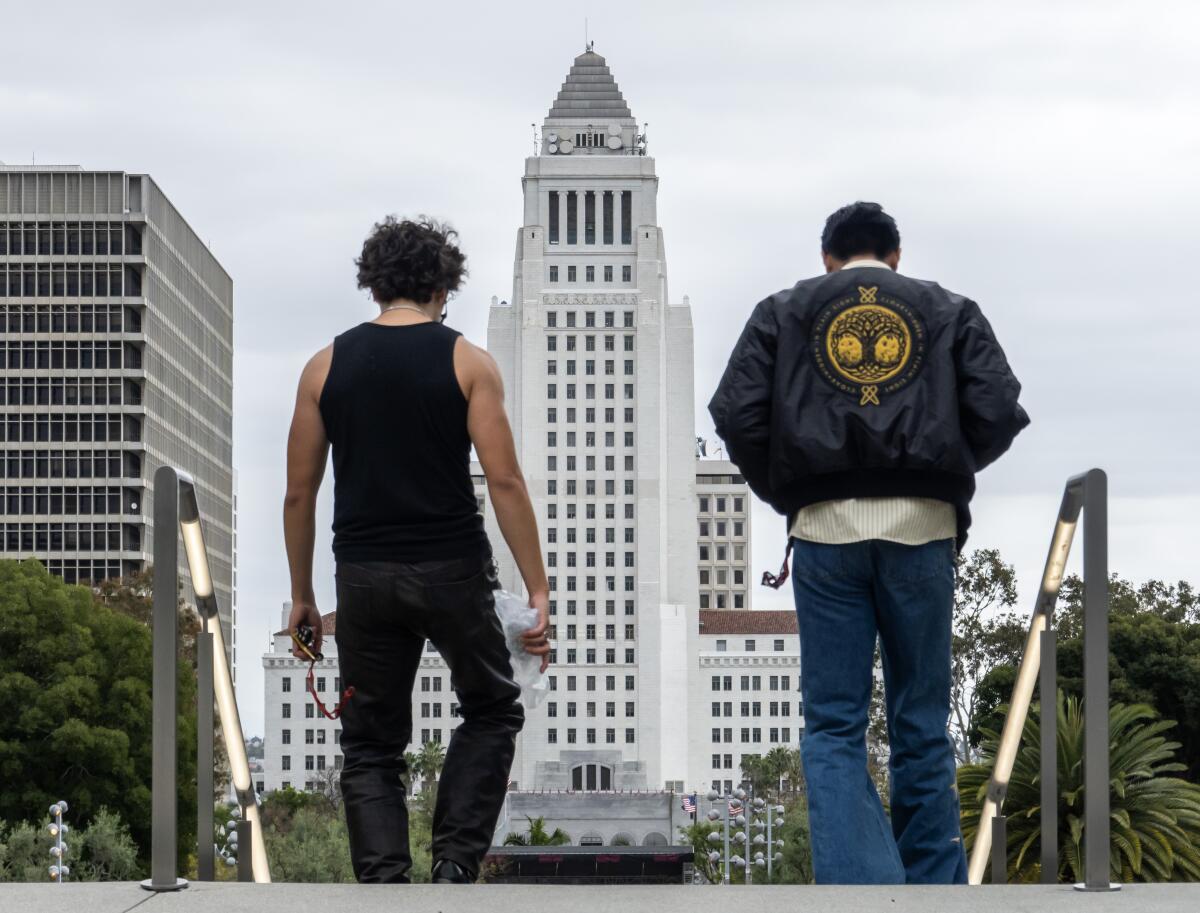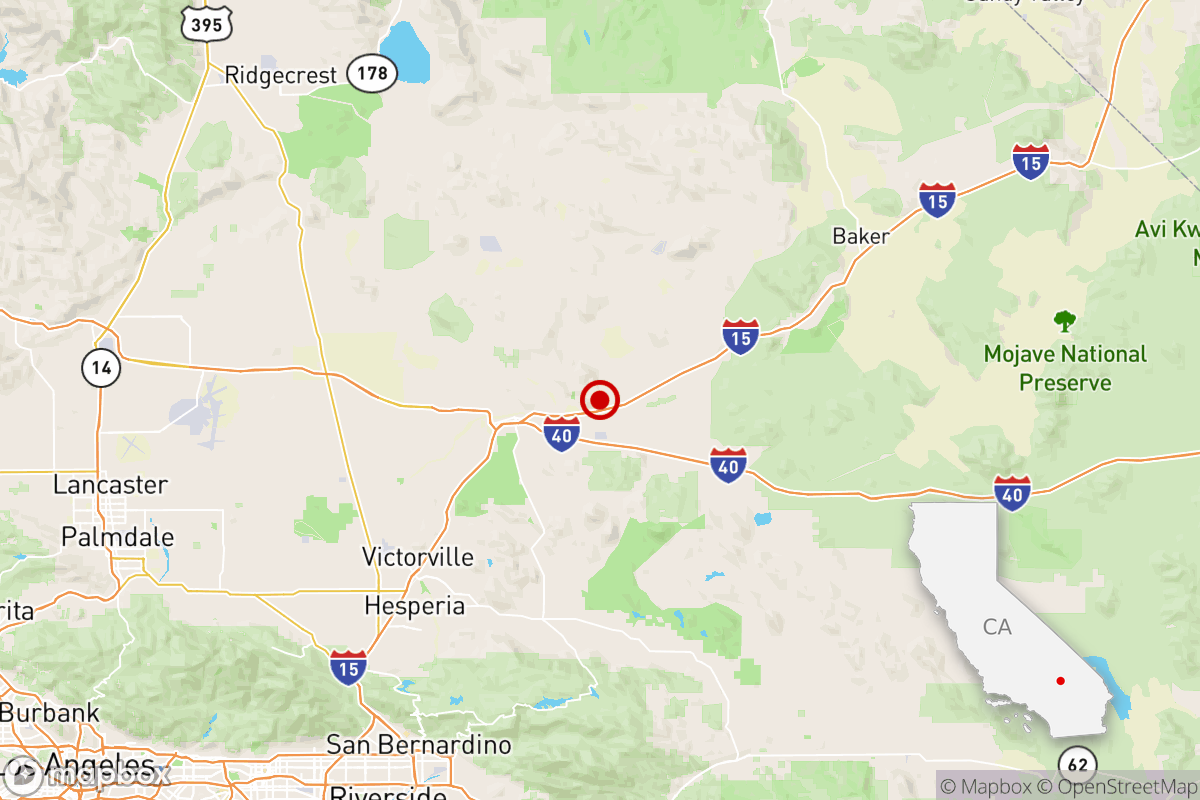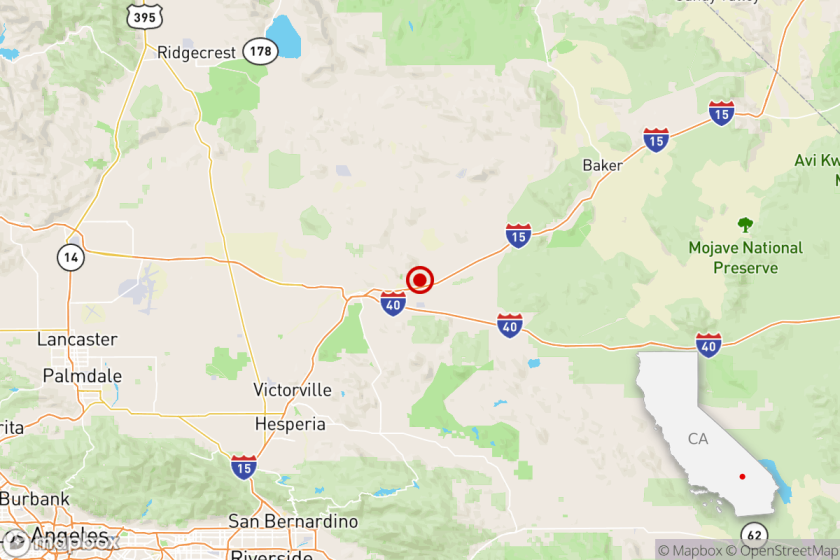Why earthquake in L.A. felt terrifying to some, nothingburger to others — even in the same building

- Share via
The magnitude 4.9 earthquake that rattled Southern California on Monday spurred some classic questions: Why did it feel like it lasted so long for some and so short for others, and why did some not feel it at all?
It is not surprising that people by the epicenter near Barstow felt the strongest, longest jolt.
But in the Los Angeles Basin, some residents felt nothing at all, while others reported swaying for as long as 15 seconds.
In Pasadena, about 95 miles southwest of the quake’s epicenter, U.S. Geological Survey geophysicist Morgan Page felt nothing while walking on the first floor, but her colleague, who was sitting in a chair on the second floor, felt shaking for a couple of seconds.
And next to Los Angeles International Airport, on the sixth and seventh floors of The Times’ El Segundo headquarters, about 115 miles southwest of the epicenter, journalists felt 15 to 20 seconds of relatively gentle swaying.
A magnitude 4.9 earthquake was reported Monday at 1 p.m. near Barstow, according to the U.S. Geological Survey. Shaking was felt in Los Angeles.
The ground under you matters
For people at the epicenter of an earthquake, the shaking may seem to last longer because you’re feeling weaker ground motions as well as stronger motions generated by the quake, Page said. By contrast, people farther away may feel only some of the major ground motions.
What kind of rocks and soil are beneath your feet also matter.
If you’re in a basin — whether it be the Mojave Basin or the Los Angeles Basin — “you have basically shakier sediment” beneath you that can produce “longer duration shaking, and it also amplifies the shaking,” Page said.
Earthquakes are a way of life if you live in Los Angeles. But what about when you never feel them — even as your Shake Alert is blaring and your friends are buzzing about the temblor?
The Los Angeles Basin is a 6-mile-deep, bathtub-shaped hole in the underlying bedrock filled with weak sand and gravel eroded from the mountains and forming the flat land where millions of people in Southern California live. When earthquake energy is sent into these sedimentary basins, it amplifies the intensity of the shaking — perhaps 10 times worse than if someone were on bedrock — and also causes shaking to resonate like a bowl of Jell-O, extending the duration.
“You get waves trapped in the basin, and that just makes the shaking last longer. But you also get amplifications, so you’re feeling waves as higher amplitude, and therefore stronger shaking that, without the amplification, you wouldn’t have felt. So both are contributing to this duration,” Page said.
People who are sitting are more likely to feel shaking than those who are walking or moving. “If you’re doing something versus if you’re sitting still, it makes a big difference,” she said.
The guide to earthquake readiness and resilience that you’ll actually use.
Higher floors amplify the shaking
How high up you are in a building also matters.
Shaking will be felt more strongly by people on a higher floor than on the ground floor, Page said.
Imagine if you had a table and attached a spring upward, and had a weight on it — like an inverted pendulum. “If you shake the table, the top of that spring is going to wobble a lot more than the bottom,” Page said, explaining how people on the top floor of the same building would feel a lot more movement than those on a lower level.
“On the bottom floor, you’re attached to the ground. And on the top floor, you’re swinging around on this part-flexible, part-stiff structure,” Page said.
Lessons from Ridgecrest
The difference in shaking was readily apparent during the 2019 magnitude 7.1 Ridgecrest earthquake, which had an epicenter 125 miles northeast of downtown L.A.
During that quake, someone sitting in the lobby of a downtown skyscraper might have felt a few seconds of light shaking. But up on the 50th floor, the experience was terrifying, with sensors on that floor swaying back and forth as much as a foot in each direction for two to three minutes.
On the 48th floor of another downtown building, one woman felt vertigo and her husband felt motion sickness after what seemed like minutes of swaying.
Data from seismic sensors in buildings across Southern California show how the 7.1 Ridgecrest earthquake produced surprisingly long periods of shaking in some areas.
“Seasickness is something you get when you’re in these high-rises” during certain earthquakes, Caltech research professor of civil engineering Monica Kohler said in 2019.
Even throughout central L.A. during Monday’s quake, which struck at 1 p.m., people reported different shaking experiences. In Silver Lake, a 6-year-old tuxedo cat, Lucas, slept through the shaking, while his owner, on the third floor of an apartment building, felt a rolling motion for four to six seconds.
In the Los Feliz-East Hollywood area, one person sitting at a table felt two waves of shaking — an initial wave for about three to four seconds, followed by an easing of shaking, and then a second wave in which the walls trembled for five to six seconds. But someone else nearby, who was standing, didn’t feel anything.

P waves and S waves
Los Angeles was likely too far away from Monday’s epicenter for anyone to feel the quake’s “P” wave — the first type of shaking wave an earthquake generates, in which the rock vibrates in the direction of the moving wave. But someone in L.A. could have felt the “S” wave, in which bedrock oscillates perpendicular to the direction of the propagation of the wave, according to Page.
The last bit of shaking felt here may have resulted from longer-period surface waves coming in later, Page said. Surface waves are the longest lasting waves that come in and travel along the earth’s surface, arriving even after the S waves.
The surface waves are “often the waves that feel like you’re on a boat. They’re almost kind of the waves that make you motion sick, versus the jittery P and S waves you get earlier,” Page said.
Times staff writers Jim Buzinski, Brittny Mejia, Joel Rubin, Nathan Solis and Terry Tang contributed to this report.
More to Read
Sign up for Essential California
The most important California stories and recommendations in your inbox every morning.
You may occasionally receive promotional content from the Los Angeles Times.














